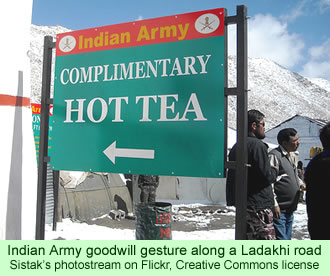The Indian Army has attempted for years to put a peaceful face on its mission in northern India, but the Ladakhi—and the rest of the people in the state of Jammu and Kashmir—still decry the military presence.
 A journal article in 2008 explained that the army tries to generate support from the people of Ladakh through its Operation Sadbhavana, which means, literally, “goodwill among people.” Similarly, at a military exhibition in Ladakh in 2011, the army enthusiastically displayed its hardware, hoping, in the words of the commanding officer in the region, to spread the word “that we love the people of Ladakh and we really want to salute them.”
A journal article in 2008 explained that the army tries to generate support from the people of Ladakh through its Operation Sadbhavana, which means, literally, “goodwill among people.” Similarly, at a military exhibition in Ladakh in 2011, the army enthusiastically displayed its hardware, hoping, in the words of the commanding officer in the region, to spread the word “that we love the people of Ladakh and we really want to salute them.”
According to a report in the Indian press last Friday, many people in Ladakh, and the rest of the state, are still skeptical that the army plays a beneficial, peaceful role in their affairs. Although local officials appear to appreciate the Rs. 40 crore (US$6,380,000) that the army spends annually on development and social programs in the state, locals maintain that the money will not erase the memories of brutal incidents that have occurred.
Army personnel maintain that programs such as Operation Sadbhavana are the best way to get people to accept the fact that army personnel need to do such things as search women and children, perform traffic checks, and examine curfew passes.
A register at the headquarters of one brigade in the Kupwara District of the state shows that between 10 and 15 people visit the facility every day to talk with army officers about development concerns. However, an assessment made by the army itself last year indicated that 46 percent of the people in that same district still do not trust the military.
A college student, Abdul Latif, also from the Kupwara District, told the reporter about a search operation by the military in a couple villages in 1991 during which troops allegedly raped some women. The perpetrators were not brought to justice. The “building of a few schools and bus stands or for that matter providing ration[s] to the needy does matter, but would certainly not encourage people to forget the unforgettable atrocities,” he said.
More recently, three civilians were assumed by the army to be foreign terrorists and were killed, an incident that prompted massive protest demonstrations. Moreover, some of the development projects instituted by the army have not been well built—such as roads that crumbled soon after completion.
M.M. Ansari, one of the interlocutors appointed to attempt to develop a blueprint for peace in Jammu and Kashmir in October 2010, argues that only the development of local and state civilian administrative bodies can forge a lasting peace in the state. Having the army assume such duties is an inappropriate way of achieving such peace, he maintains.
Others warn that when funds allocated to the military for civil works projects disappear without explanations, the army’s supposed peaceful image is further harmed. Sheikh Showkat Hussain, a law professor at Kashmir University, warns that problems such as missing money undercut the deceptive appearances of peacefulness. He blames the problems on vested interests, which he describes as people who harvest everything in order to defend the status quo and who then brand everyone else as a militant or a stone thrower.